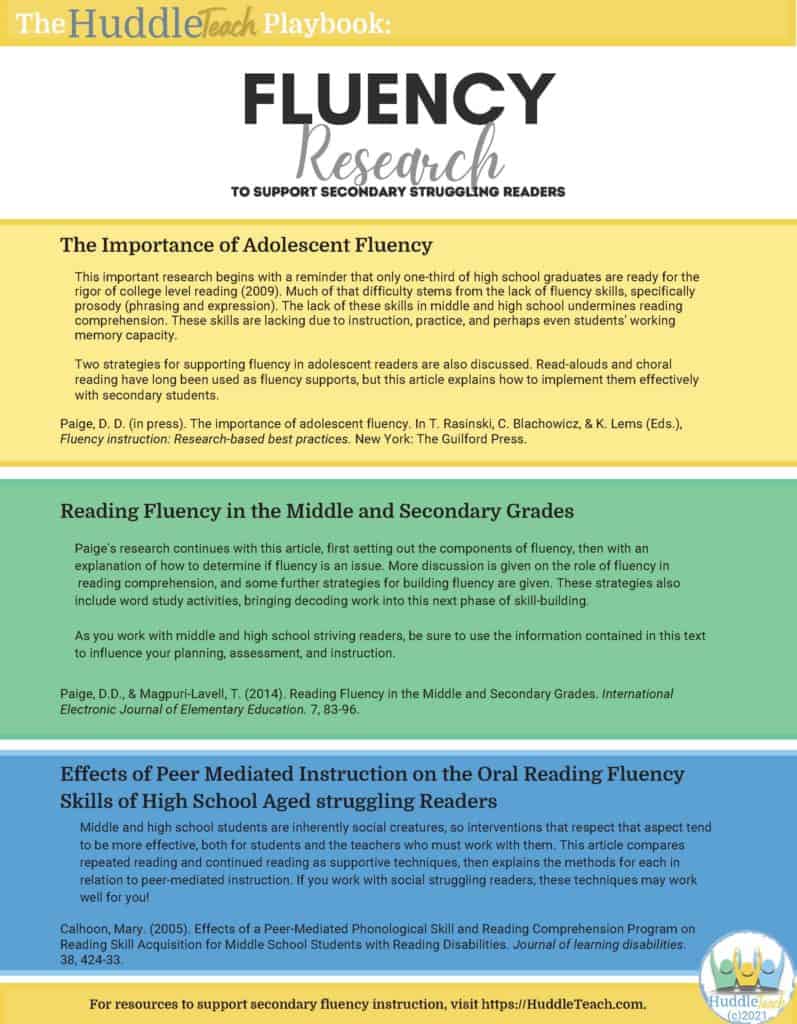Support for Fluency Interventions in Secondary Reading
Secondary teachers often assume older students have mastered early reading skills, including decoding and fluency. As a matter of fact, many secondary ELA teachers have trouble defining the role fluency plays in reading comprehension because it wasn’t included in any pre-service work. (Be sure to check out the HuddleTeach.com/blog for more posts about fluency as it appears in secondary reading.) If you work with high or middle school struggling readers, here are some important research and journal articles to help you as you support fluency skills.

“Words mean more than what is set down on paper. It takes the human voice to infuse them with the shades of deeper meaning.”
Maya Angelou, I Know Why the Caged Bird Sings, p. 82
The Importance of Adolescent Fluency
David D. Paige, 2012
Finding an article completely focused on the role of fluency in secondary reading comprehension is so refreshing! First, Paige discusses NAEP results that show reading growth through fourth grade but a decline through secondary grades. One reason for the decline may be lack of fluency skills. He goes on to examine the relationships between reading fluency, comprehension, and academic achievement. He also includes more recent information about the importance of reading with expression and prosody’s contribution to reading comprehension. Paige includes two techniques for fluency intervention – read alouds and choral reading – as well as additional research around reading motivation and interest linked to oral reading fluency. This is a valuable read for anyone who works with adolescent struggling readers!

Reading Fluency in the Middle and Secondary Grades
David D. Paige, Theresa Magpuri-Lavell, 2014
Paige’s conversation about fluency continues in this article, including a review of other secondary fluency research. In fact, it includes data from an author in India with implications for fluency levels of students learning English as another language.
If you are unsure of the components of fluency, especially for secondary students, read this text! It will explain everything, including suggestions for identifying when a reader is not fluent. Paige discusses several strategies beyond his 2012 article for supporting the development of fluent reading with an additional emphasis on the contribution of word part knowledge (morphology) to fluency. No matter your level of understanding, this article has it all!
“Dick Allington and Rachel Gabriel say that every child should hear a proficient reader read aloud every day (2012). Striving readers need this in spades. They need to hear what natural, fluent reading sounds like. One way to build fluency is to read aloud with expression frequently.”
Harvey & Ward, From Striving to Thriving, 2017, p. 183
Effect of Peer Mediated Instruction on the Oral Reading Fluency Skills of High school Aged Struggling Readers
Nikki L. Josephs, Kristine Jolivette, 2016
It’s not too late to help older struggling readers, but what works with younger students does not always have same effect on older students. More and more studies are indicating that it’s the prosody component of fluency that supports comprehension in older students. And we know that older learners are social learners – that their relationships with peers matter. So how do we combine fluency interventions with peer work? We use peer mediated reading instruction! This article explains its benefits and the procedures for implementing this effective method.
More Information to Partner with Fluency Research
We will continue to share Nell Duke’s important paper, The Science of Reading Progresses: Communicating Advances Beyond the Simple View of Reading (Duke & Cartwright, 2021). This text reminds us that even though fluency is an indicator of students who need reading support, more than 30% of secondary students needing that support show NO fluency need. In other words, these students sound like great readers but they are not understanding what they are reading. Of course in this case, spend time on comprehension instruction, not fluency supports. Watch this blog for upcoming posts regarding comprehension strategies.
Need to know more about fluency in secondary reading instruction? These may help:
- Key Literacy Component: Fluency explains this reading component in secondary grades. It is an easy-to-read guide of what fluency looks like in middle and high school and explains a few effective interventions.
- Five Oral Reading Fluency Strategies for Supporting Struggling Adolescent Readers details and provides links for fluency supports. If you work with older students, this list of resources is for you!
Need to share fluency research? Download a free copy using the button below:

Of course, congratulations on your work with struggling adolescent readers! This type of work is not for the faint of heart and requires a certain level of reading knowledge and teen understanding. We hope you mark this website as a favorite for finding tools and information to make your job easier! Remember to join the email list below for weekly resources, information, and freebies! (We respect your privacy and will never sell your information.)

